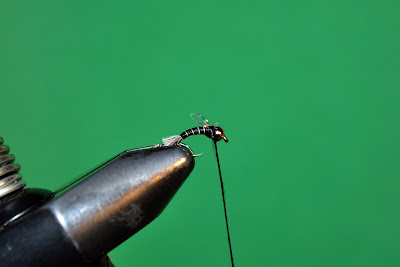I fish it a variety of ways. Often I will fish it with a double nymph rig as the bottom fly fishing it deep with the aid of split shot. In the spring I like to use it as a dropper off an adult Skwala Stonefly pattern on rivers that have that hatch and fish it in the top foot of the water column. It will work all year I am sure but my focus during the summer seems to shift to the many other hatches that take place and my use of this midge pattern takes a back seat.
Midges though are a popular winter staple for trout as they do hatch in many locations all year. Even on a cold winter day, the mid day sun can warm things up enough to bring about a midge hatch that will bring even the most lethargic of cold blooded trout to the surface.
This pattern is basically a Zebra Midge with a few slight modifications. It’s simple to tie, and has for the last couple years been my top fish catching pattern on a variety of rivers.
Figure 1-I usually tie this pattern on hooks size #18 or smaller. This one is on a #18 TMC 2457.
Figure 2-Push a 2mm nickel bead onto the hook.
Figure 3-Lay a base of black thread then I tie in a short tail of a few grizzly hackle fibers. Midges do not have a tail like a mayfly but I tie this with a few fibers at the end as I like to think it gives a little wiggle to the end of the fly.
Figure 4 – Tie in a short section of fine silver wire and advance the thread to the head of the fly building a slight taper with the thread as you go.
Figure 5 – Make evenly spaced wraps with the wire up to the head and tie off with the thread.
Figure 6 – Tie in a small loop of Iridescent Krystal Flash. Then whip finish and drop some head cement on the head and a little on the body of the fly.
Figure 7 – The finished product.
















 I understand this is not an unheard of journey for a fish that has very close relatives (
I understand this is not an unheard of journey for a fish that has very close relatives (